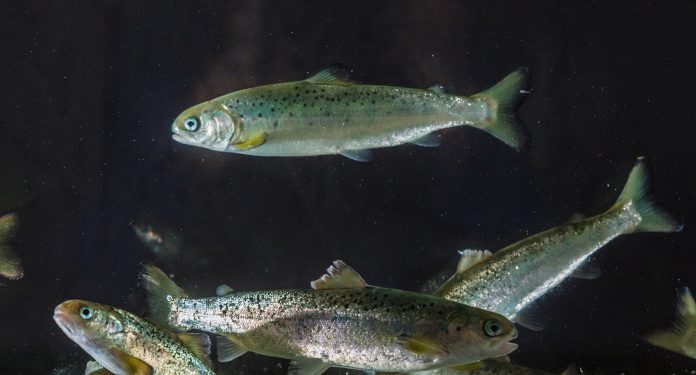Breeding salmon for growth or resistance to sea lice in cold waters may have little effect if the offspring grow up in warmer waters.
The latest research from Norwegian Institute of Food, Fisheries and Aquaculture Research (Nofima) Nofima has been looking at breeding and sea lice in relation to climate change.
“With climate change and more frequent heatwaves in the ocean I think this is useful information for breeding companies who are breeding for growth or resistance to sea lice,” said Nofima scientist Celeste Jacq.

The individual characteristics of both salmon and sea lice can determine whether the sea lice attaches to and feeds on a salmon. The fact that resistance to sea lice is hereditary in salmon is known from previous breeding and genetics research by Nofima. By drawing in expertise from fish health, production biology and chemistry, Nofima was able to answer a broader question: How to increase robustness in salmon and lumpfish in the face of climate change. This resulted in the establishment of the strategic initiative FutureFish, supported by the Research Council of Norway.
Growth and lice activity are temperature-dependent
Let’s look back to the start of the trials in the winter of 2017 when fifty salmon families from the fish farming company Mowi were distributed across different tanks at the Aquaculture Research Station in Tromsø. At the start of the trial the salmon weighed 100 grams, and were reared in seawater of 5, 10 and 17°C. A few weeks into the experiment, the researchers added young sea lice to the tanks and measured the effect on the salmon. They counted the number of sea lice, took samples of mucus and skin and measured the size of the fish. They analysed the DNA for 45,000 genetic markers and examined the relationship between the lice load (i.e. how much lice attach to the salmon) and salmon growth at the different temperatures.
The genetic analysis revealed that neither growth nor the lice load are single traits, but rather that they vary with water temperature. There is only a weak to moderate genetic correlation between salmon growth in seawater at 5°C and 17°C.
“The good news is that it is possible to breed for reduced temperature sensitivity to ensure increased salmon growth and resistance to sea lice even in fluctuating temperatures”, said Jacq.
The project had several interesting results that indicate why different salmon characteristics are associated with sea lice resistance at both high and low temperatures.
The salmon’s smell and lice infestation are linked
Nofima scientists John-Erik Haugen and Gareth Difford combined their respective knowledge about aroma compounds and genetics and found some volatile organic compounds in the salmon skin mucus that seem to attract sea lice in much the same way that human odours attract mosquitoes.
“We also found that the salmon families that are resistant to lice produce less of these compounds, and vice versa”, says Difford.
The scientists will investigate this further in a new project that aims to utilise species-independent variation to improve sea lice resistance and is funded by the Norwegian Seafood Research Fund.
The fish health researchers also found structural differences in the skin of the salmon. The outermost barrier of the skin, the epidermis, was thinner in fish that had been reared at 17°C and had markedly smaller mucus cells. The combined results may indicate that the fish skin barrier weakens over time when the fish lives in warmer water.

In addition, the researchers found chemical differences in the mucus between fish from high and low-temperature tanks. How these mucosal properties impact fish health will be investigated further.
Breeding lumpfish to eat more lice
Finally, the scientists used genomic information to examine the heritability of sea lice eating ability in lumpfish. The heritability for this trait was low, but there were significant differences between families.
This means that it is possible to use genetic selection to increase lice eating ability through breeding programs, which can reduce the reliance on wild-caught cleaner fish and chemical delousing agents


